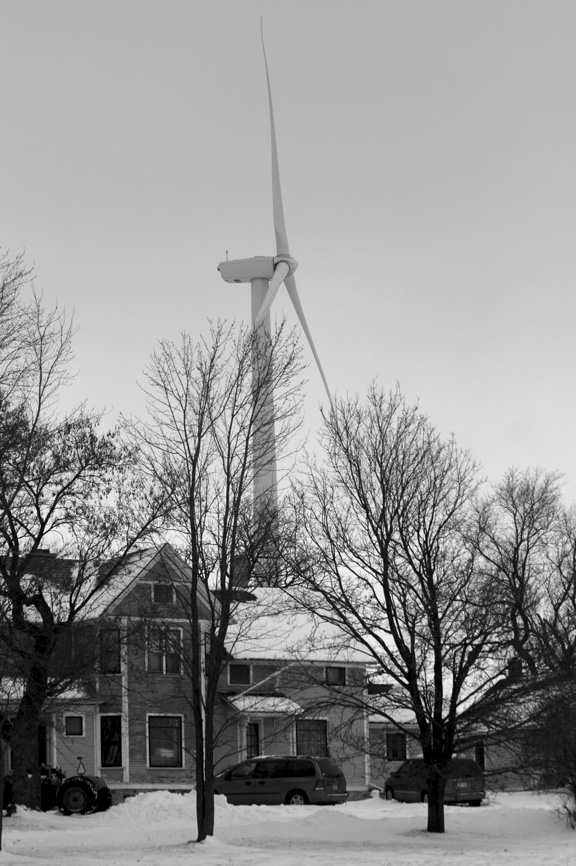Entries in wind property values (2)
4/23/10 What's all this noise about turbine noise? Whose word will you take? Someone who profits from putting turbines close to people's homes, or someone who is living with turbine noise every day?
Veteran noise engineer George Kamperman, Board Certified in Noise Control Engineering by the American Institute of Noise Control Engineering, wrote the following commentary after listening to a video clip (above) recorded by Larry Wunsch who lives near the Town of Byron in Fond du Lac County, Wisconsin. The closest turbine to his home is 1100 feet away. Wunsch is a firefighter and also happens to be a member of Wisconsin's Wind Siting Council, a fifteen member group who are now at work on creating guidelines for siting turbines in our state.
There is a must-see-and-hear 9 minute DVD by Larry Wunsch at his home in Byron, Wisconsin. Turn up the volume on your computer and listen either through earphones with good uniform base response, or listen from a full frequency range sound system.
You may be shocked by what you hear. The wind turbines make a roaring sound like a jet aircraft. The wind turbines radiate an excessive amount of low frequency energy, and this is the primary reason for our new approach (see How Loud Is Too Loud?) for determining wind turbine setback from dwellings.
Whenever you read about noise levels in the media, the decibel (dB) numbers are frequency weighted (dBA). The term is the “A-weighted” sound level. This frequency weighting discriminates against low frequency sounds, somewhat similar to human hearing response at low sound levels. The wind turbine industry has taken advantage of the phenomenon to show wind turbines produce sound levels no higher than the sound from “a gentle breeze rustling leaves of a tree” or “a small flowing stream” or “the refrigerator in your kitchen,” to cite just some of the examples argued by the wind turbine lobby. These examples are all plausible, and the industry probably has data to show it to be true.
What’s wrong with this picture? The wind industry examples definitely do not sound like the jet engine noise outside the home of Larry Wunsch! The problem is that wind turbines generate far more low frequency noise than high frequency noise where dBA is most sensitive. This is a dirty little secret the wind turbine industry has been hiding from the public.
To meet this challenge we have added (again, see How Loud Is Too Loud?) a requirement that both dBA and dBC noise data be published by the wind industry. The dBC frequency scale has a flat, uniform response throughout the audible range and thus is a better measure of any noise rich in low frequency sound. We propose wind turbine setbacks must meet both dBA and dBC limits.
I did an actual instrumentation analysis of the Larry Wunsch (YouTube) turbine noise recorded outside his front door. My measured noise characteristics agreed with the manufacturer’s claimed noise emission. Both sets of data show excessive low frequency noise outside the Wunsch home, and they show the dBC (broadband) turbine noise to be 13 dB higher than the dBA (high frequency) turbine noise.
Whenever dBC results exceed dBA results, it is a clear indication that low frequency noise not measured by dBA is in fact present. Noise engineers know this; the general public does not. The industry example of rustling leaves, above, would necessiate dBC one dB ldBA lower than dBA, which is clearly not the case outside Mr. Wunsch’s front door.
Behold the wind industry chicanery (deceit) when it pretends rustling leaves = whispering turbines. Rubbish!
Think of dBA and dBC as tone controls for listening to your favorite music. The treble control being the dBA, and the bass control being the dBC. A uniform random noise is often referred to as white noise. When you reproduce white noise and turn down the treble control (dBA) for reduced highs, and turn up the base control (dBC) for more “boom,” you end up with sound close to the wind turbine noise spectrum.
Or consider this illustration. All propellers produce what’s often called a “haystack” spectrum, where the top of the haystack (peak energy in the spectrum) is determined primarily by the diameter of the propeller circle (twice a blade radius). Think of the whining sound of small model airplanes. Next, think of the engine sound of an ultralight (single-person) aircraft. In this case the engine sound has a lower frequency than the remote-control model airplane. Next, think of the engine sound of a standard, single-engine plane. A Cessna or Piper Cub, let’s say. The engine sound is lower than the ultralight’s. Finally, imagine a B-36 bomber aircraft, where the engine pitch is lower yet.
The point being, as the propeller-sweep-circle-diameter increases, the top of the haystack pitch, or frequency, shifts downward.
Now, graduate to wind turbines. The biggest of them all. Huge propellers sweeping an enormous circle. Propellers so big that the peak of the haystack (peak sound energy) is in the 10 and 20 Hz range–and the peak is no longer audible. Even so, turbine propellers generate plenty of sound energy on the high frequency side, sliding down (increasing frequency) the high frequency side of the haystack, with the result that wind turbine sound spectrum continues to be very audible indeed.
The standard noise meter has had the same two, dBA and dBC, sound weightings since the instrument was invented (around 1940, I believe). The peak in the haystack spectrum for wind turbines is below the frequency range of both human hearing and the range of a standard sound-level meter (10 Hz to 20,000 Hz). In fact, the sound-level meter dBA response becomes increasingly less sensitive to sounds below 500 Hz (2 octaves above middle C on the piano), and has a uniform sensitivity at higher frequencies above 500 Hz. The dBC response, on the other hand, remains uniform thoughout all frequencies above 32 Hz (equivalent to the lowest note on a grand piano) to the upper limit of the instrument (which is 20,000 Hz). The low frequency roll-off below 32 Hz is standardized down to 10 Hz. Thus, this instrument is somewhat useful for near infrasound.
Wind turbines, by the way, do indeed produce infrasound, contrary to misleading statements by some acousticians. Since there is no ANSI (American National Standards Institute) or IEC (International Electrotechnical Commission) standard suitable for dealing with wind turbine infrasound, Rick James and I have sidestepped the issue for the time being in our “How To” guide. Rural America will be flooded with wind turbines of questionable value long before a consensus emerges among noise engineers on dealing with wind turbine infrasound. Individuals and communities who are understandably suffering from the infrasound and low frequency noise of turbines cannot wait for ANSI and the IEC to catch up with their dilemma. That’s why my colleague, Rick James, and I have jumped in and made do with the best off-the-shelf technology, instrumentation, and international noise standards currently available. When health and homes are under assault, as the research of Dr. Pierpont and many others makes clear they are, it would be unconscionable for someone with my training to look the other way.
Somehow we need to convince government... that wind turbines must be kept away from people’s homes. That many of these wind farms are in areas of marginal wind energy value makes this even more tragic.
-George Kamperman
3/10/10 What's it like to live in a Wisconsin wind project? It's been two years, are you used to it yet? AND How were you getting those transmission towers here?
What's it like to live in the 86 turbine Invenergy Forward Energy wind project?
 Home in Invenergy Forward Energy project, Fond du Lac County--- photo by Gerry Meyer 2009
Home in Invenergy Forward Energy project, Fond du Lac County--- photo by Gerry Meyer 2009
Here are two recent notes to Better Plan from the Meyer Family. They are residents of the Invenergy Forward Energy wind project near the Town of Byron in Fond du Lac county.
Since the turbines went online near their home two years ago, they have had trouble sleeping, increased blood pressure, ringing and crackling in the ears and headaches. Cheryl has been taking sleeping medication, something she never needed before the turbines started up.
The closest turbine to their home is less than 1600 feet.
From Cheryl Meyer
March 8, 2010
"The turbines are so loud that our dog, Trigger, goes to the backroom window and barks at them.
It sounds like a snowplow driving around the house full bore with its blade down.
I find it interesting the last few days that when I go out with the dog he goes so far down the sidewalk and then turns and looks north to the turbine. He stares at it a few seconds and then moves on.
But they have been usually loud the last two days. Just thought I would let you know.
Cheryl
March 9, 2010
From Gerry Meyer:
Cheryl has a really bad headache.
She has tried Imatrex or the shot three times in three days, so today went to the Doctor....
The message Cheryl wrote you was when I was in LA. I remember her telling me that the turbines sounded like snow plow coming through the house.
You could add that Trigger barked because that is what he does when a vehicle comes in the driveway. The turbine was so loud he thought a plow was in the driveway.
Gerry
This video was shot by Gerry Meyer from his porch.
NOTE FROM THE BPWI RESEARCH NERD:
On February 18th, I spent another night in the Meyer home to get a better idea of what they are living with and was kept up well past three in the morning by a thumping from the turbines that seemed to come from all directions.
The only thing I can compare it to is the bass sound you hear coming from a car with powerful speakers. You feel the noise as well as hear it. It was impossible to sleep until it finally stopped.
The typical turbine jet sounds and whooshing were louder outdoors than indoors, but the low thumping was penetrating and much louder inside the home than outside the home. This was especially so on the second floor.
The Meyer family home is a typical wood framed old farm house found throughout rural Wisconsin. The Meyer's young son often goes to bed with two radios playing, one on either side of his head to counteract the turbine noise.
 WANT MORE? CLICK HERE TO READ TODAY'S "WIND TURBINES IN THE NEWS"
WANT MORE? CLICK HERE TO READ TODAY'S "WIND TURBINES IN THE NEWS"